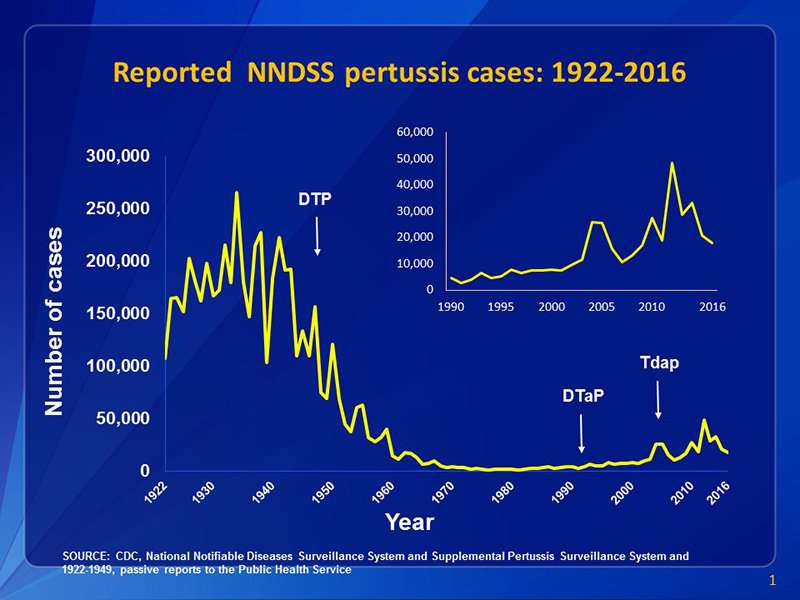Why is whooping cough on the rise?

Watching an infant suffer through a bout of whooping cough is agonizing. Blue face scrunched with effort, the baby strains to take a breath through a narrowed windpipe. She struggles, choking, for what seems like eons. Finally, a tiny puff of air squeaks in—the "whoop" that gives the deadly disease its name.
"Little babies, when they're trying, trying, trying to take a breath and they can't, it's almost like watching someone being waterboarded," says Christopher Gill, Boston University School of Public Health associate professor of global health. "In adults, it's dreadful and will eventually go away. In babies, it's often catastrophic."
Whooping cough, caused by the bacteria Bordetella pertussis, is no longer a familiar condition to most Americans. The United States began widespread vaccinations in the 1940s, which nearly eradicated the disease. But whooping cough has been increasing here over the past two decades despite record rates of vaccination: in 2016, more than 15,000 people in the US came down with the disease, and 7 people died.
The question is, why? Gill thinks it's because the vaccine isn't working well—or is not working in the way we anticipated. In the mid-1990s, doctors in the United States started switching from a vaccine containing whole bacteria to an "acellular" vaccine, one that contains only certain components of the germ. Within the next few years, the incidence of whooping cough started rising again, a pattern that has been repeated in several other counties—including England, Canada, Australia, Ireland, and Spain—that made the same switch.
"The second generation of vaccine turned out to have an unanticipated limitation, and that has been probably the main engine driving the resurgence," says Gill, who is lead author on a review article on the resurrection of whooping cough, published in the journal F1000 Research. Gill and his colleagues suspect that the vaccine, while preventing symptoms from pertussis infections for some time, has little impact on preventing people from becoming "colonized" with the bacteria, meaning they are asymptomatic carriers of the disease and are still capable of infecting others. The work pulls together several lines of research and suggests the need for a new vaccine that can prevent both symptoms and infections.

The Bordetella pertussis bacteria do their dirty work by infecting a person's upper airways and secreting a complex mixture of toxins, of which perhaps the most important and best studied is pertussis toxin. Through mechanisms that are still poorly understood, pertussis toxin provokes violent coughing spells, while evading our immune responses. The bacteria also indirectly stimulate certain white blood cells, called lymphocytes, to flood into a person's bloodstream, causing further complications. "The lymphocyte counts become incredibly high," says Gill. "When they get to a certain threshold, they start to act a bit like leukemia and sludge up the capillaries in your lungs. The babies suffocate because their lungs are plugged up with lymphocytes."
Doctors treat whooping cough with antibiotics. This kills the bacteria, but it doesn't combat the toxin. Even with an effective antibiotic, a patient will suffer for six to ten weeks before recovery.
The original pertussis vaccines, introduced in the 1940s, were "whole cell" vaccines, crafted by killing whole bacteria with heat or chemicals. "Pertussis was one of the earliest and most successful vaccines ever to come on the market," says Donald Thea, a BU School of Public Health professor of global health, and a coauthor on the F1000 Research paper. "It brought the incidence of pertussis way, way, way down." The problem, says Gill, was that these early vaccines contained "a witch's brew of bacterial components—really everything that was in the germ ended up in the whole-cell vaccines," which led to side effects like high fever, severe muscle soreness, and seizures. "Understandably, it freaked everybody out," says Thea. And as the rates of pertussis fell, society's willingness to accept the high rates of vaccine side effects also fell.
In response, scientists crafted a second-generation vaccine, one that contained only specific, and what were considered at the time to be critical, proteins from Bordetella pertussis. In clinical trials, this new "acellular" vaccine appeared to work well, with few side effects. "It seemed like a slam dunk," says Gill. So, the United States, and other countries, switched to the newer vaccines. Most American kids now get vaccinated for whooping cough with the diphtheria, tetanus, and acellular pertussis, or DTaP, shot at 2, 4, and 6 months of age, then twice before starting kindergarten.
Within a few years of the switch, however, the incidence of whooping cough began to rise. Researchers eventually found one cause: the acellular vaccine's protection wears off after two to three years. The medical community has combatted this weakness by instituting booster shots for adolescents and elderly people.

But even with the booster shots, cases continued to rise, so scientists started looking for other explanations. Eventually they found one: The new vaccine prevents people from getting sick, which is good, but it doesn't prevent them from becoming infected and spreading the disease. In a 2014 experiment published in the journal PNAS, scientists at the Food and Drug Administration found that when they gave baboons the acellular vaccine and then infected them with pertussis, the baboons had high concentrations of the bacteria in their noses, as high as their unvaccinated counterparts. "They were teeming with pertussis germs, but they had no symptoms," says Gill. "That's the chink in the armor here; we believe that these vaccines ought to create immunological firewalls in the population, but it turns out they don't."
This means that vaccinated people can still become carriers of the disease, spreading it to unvaccinated people—like very small babies—but also to people who have been vaccinated. Those individuals usually will not show symptoms of whooping cough, but they can still acquire the infection and spread it to others. That limits the effects of "cocooning," in which immediate family members are vaccinated to protect small infants. (One strategy that does seem to work is vaccinating pregnant mothers, so that babies are born immune.)
Now scientists are starting to piece together why exactly this happens: the old and new vaccines stimulate a different immune response. The original whole-cell vaccine initiated a response called Th17, which triggers the immune system's T cells to fight infections on mucosal surfaces, such as in the nose and mouth. The acellular vaccines, on the other hand, provoke a different response, known as Th2, which leads to the secretion of antibodies into the bloodstream. In this case, the germs continue to live happily in the infected person's nose, mouth, and throat, where they can easily spread to others.
Gill and his colleagues say that all these lines of evidence point to a need for a new vaccine. "There's a lot of interest in creating a third-generation pertussis vaccine," says Gill. "That's great, we should do that, but we need to be able to show that it prevents disease and infection, not just disease."
More information: Christopher Gill et al. The relationship between mucosal immunity, nasopharyngeal carriage, asymptomatic transmission and the resurgence of Bordetella pertussis, F1000Research (2017). DOI: 10.12688/f1000research.11654.1

















